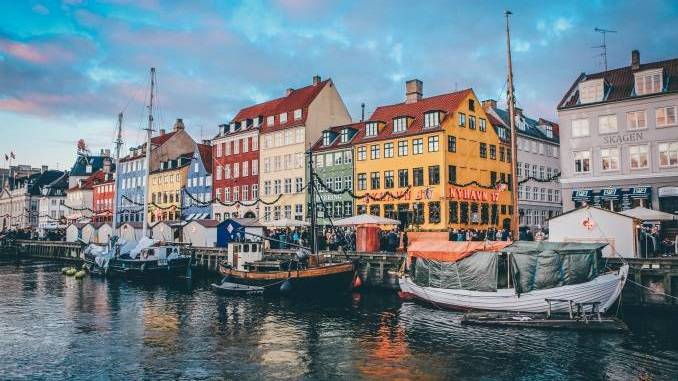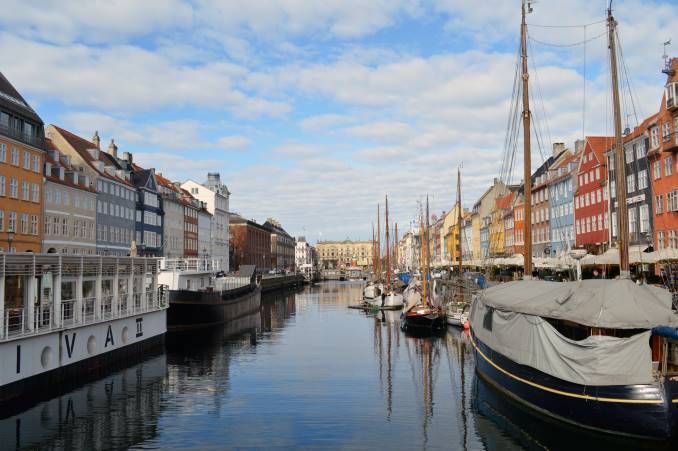Your Summer Travel Guide To Copenhagen, Denmark
All photos from Unsplash
Located at the gateway to Scandinavia and often unfairly overlooked compared to its more famous European counterparts, Copenhagen has a lot going for it. Frequently ranked one of the happiest cities in the world, the Danish capital boasts stunning European architecture, a rich culture, and laid-back vibes punctuated by “hygge” (a Danish term roughly translating to “cozy vibes”). With these and a few unique, endearing twists of its own, Copenhagen is an absolute must-stop on your next trip to Europe.
Like many other European cities, Copenhagen has a robust subway system that goes virtually everywhere. However, it is recommended to get around the way the Danes do: by bicycle. Copenhagen is arguably the most bike-friendly city in the world, with all primary thoroughfares and many sideroads hosting bike lanes. It is not uncommon to see more cyclists than cars on the streets. The ubiquity of bikes, in conjunction with the city’s small size, general flatness, and varied, gorgeous scenery, make it the ideal way of getting around. While there are many options for securing a rental, the Donkey Republic app is recommended. Many other options require Wi-Fi, which might not be available for international visitors on a roaming phone signal. Donkey Republic only requires Bluetooth—no internet access is required. Check out these places once you’ve got your wheels.
Nørrebro

This hip neighborhood, located just north of downtown, lives up to its trendy reputation with streets lined with fantastic yoga studios, quirky vintage stores, and an overall creative, bohemian vibe. Enjoy a relaxing walk along the Søerne (The Lakes in English) flanked by gorgeous Danish architecture, take a vinyasa class at The Yoga Loft, or browse the offbeat vintage offerings along Nørrebrogade and Ravnsborggade. Indulge in Copenhagen’s fantastic culinary scene at one of the many vegan-friendly options on Jægersborggade, or enjoy some live music while grabbing a bite from a food truck in nearby Folkets Park, one of several stunning green spaces within Nørrebro. The large and diverse Hans Tavsens Park nearby is perfect for idyllic bike rides through the lofty trees, hikes through the dense, flowery gardens, or a simple, relaxing day in the sunshine with a good book in hand. The fairytale scenery is perhaps no accident, as the park is also home to Assistens Cemetery, the burial ground of Hans Christian Andersen and several other Danish luminaries. Finally, don’t miss Superkilen Park, a notable public space divided into three unique zones. The “green zone” offers quaint grassy areas with public benches, and the bustle of skaters on brick terraces fills the sports-centered “red zone.” At the heart of the park lies the “black zone,” a meeting place of benches and tables intertwined with ubiquitous waves of white lines on pavement marking topography. Superkilen showcases Copenhagen’s diversity through bits of internationally-inspired objects and art enhancing the park’s character. Grab a cappuccino from one of the several cute cafes nearby and discover these seemingly-random foreign items, including Russian neon signs, Moroccan fountains, Turkish benches, and exercise equipment from California.
Vesterbro and the Meatpacking District

Once considered one of the seedier parts of towns, the Vesterbro district has undergone a renaissance in recent years, with scores of gourmet restaurants and lively bars popping up within the formerly industrial neighborhood. The warehouses of the Meatpacking District conceal a veritable foodie’s paradise, with seafood, Japanese, and vegan-friendly options awaiting discovery among the wealth of available cuisines. More of Copenhagen’s idyllic green spaces can be found along the lush Sonder Boulevard or Skydebanehaven, the latter of which is a former 19th century shooting range whose ornate wall, originally designed to protect pedestrians from bullets, still stands. Solo travelers should consider a stay at Urban House, a funky hostel in the heart of the neighborhood, and visit nearby Absalon, a charming community center doubling as a centerpiece to Copenhagen’s quirkier side. Make a new friend during the nightly community dinner, inexpensive and open to the public, or enjoy the eclectic events ranging from hatha yoga classes to art workshops to wild dance parties. Explore gorgeous photography and art exhibitions within the V1 and Poulsen Galleries, both located in the Meatpacking District. In the evening, catch a show at Vega, an iconic venue with a cozy, wooden aesthetic occupying a building known as The People’s House, formerly a vital meeting ground for the Danish labor movement. The unique setting allows Vega to offer a multitude of musical experiences across all genres within its many-sized rooms, ranging from massive, blockbuster affairs to smaller, more intimate gatherings.
Indre By and Nyhavn

Centrally located Indre By contains much of Copenhagen’s stunning architecture, notably in Amalienborg and Rosenberg Castles. The latter, a majestic 17th century structure in the Dutch Renaissance style, is surrounded by the charming, expansive Kongens Have (King’s Garden). Further north towards the waterfront lies the charming windmills of the Kastellet, formerly a 17th century fortress built on a green, star-shaped island now covered in bike trails and host to live music concerts during the summer. For a memorable day of thrills, head to the iconic Tivoli Gardens, the second oldest amusement park in the world. Take a riveting ride on The Demon roller coaster, explore the lush, colorful Chinese garden, or enjoy the pleasant live music from one of the many stages located throughout the park. For a fun dose of Danish nightlife, head over to Hotel Cecil. After midnight the hotel transforms into Cecil AM, a rowdy dive bar offering wild dance parties and locally produced alcohol in a cozy basement bar. Heading east towards the waterfront from Indre By, the colorful row of structures comprising the Nyhavn district reveal themselves to offer one of Copenhagen’s most iconic photo opportunities. Bisected by a canal and flanked by scores of high-end restaurants, grab a table outside and enjoy the breeze with a gourmet meal and aperitif in hand.
Christianshavn and Holmen

While the numerous tour boats frequently spotted around town can be a fun way of seeing the Danish capital, consider picking up an oar and exploring the canals yourself via kayak. In addition to boasting a hip bar, Kayak Republic offers rentals promising a memorable means of exploring Copenhagen’s waterways. The ubiquitous channels of Christianshavn make for a perfect choice for an aquatic journey, and for dinner, paddle north towards the Holmen District and enjoy a farm-to-table meal at the waterfront restaurant La Banchina. From there, head north to the Reffen district, offering the largest selection of street food in Scandinavia as well as live music, trivia, and craft workshops. The artistically inclined will find plenty to love at the nearby Copenhagen Contemporary, a former welding facility now home to a maze of dazzling avant-garde art pieces. If a day on the water doesn’t sound appealing, there is still plenty to do in the area on foot. Enjoy the charming artisanal coffee shops and vintage stores within Christianshavn, or gaze towards the Øresund Strait from atop the Culture Tower, offering an incredible view of downtown Copenhagen.
Freetown Christiania

No trip to Copenhagen would be complete without a visit to Freetown Christiania, one of the most unique regions of any city in the world. Christiania’s origins started in 1971 when a group of hippies began squatting in an abandoned military base just outside of Christianshavn. Christiania blossomed into its own vibrant community over time, evolving into an iconic meeting place of the Danish counterculture. The people-watching is unmatched within the Green Light District, where the shouts of colorful merchants selling marijuana can be heard from podiums typically painted with a whimsical portrayal of the strain for sale. The quirky nature of Christiania is absolutely ripe for exploration on foot, with a visual overload of bizarre art seemingly around every corner waiting to be discovered. Many houses and buildings are covered with offbeat art installations and murals, and the ALIS Wonderland skate park hosts arguably the best display of street art and graffiti in the city. Grab a coffee from Cafe Nemoland, see live comedy and music at Christianias Jazzklub and Børneteater, or check out the numerous outdoor markets around the area showcasing the neighborhood’s creativity. Christiania’s proximity to waterways offers many pleasant walking trails within the neighborhood park, overlooking a beautiful city lake and an incredible place to observe the sunset. Stick around the massive food court for a fun place to spend a summer evening, with a plethora of food trucks to choose from and a large outdoor stage offering live music in the unmatched Christiania spirit.
John Sizemore is a travel writer, photographer, yoga teacher, and visual entertainment developer based out of Austin, Texas. Follow him on Instagram at @sizemoves. In his downtime, John likes to learn foreign languages and get immersed in other worlds, particularly those of music, film, games, and books in addition to exploring the world.







































